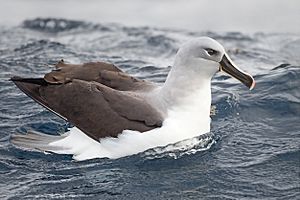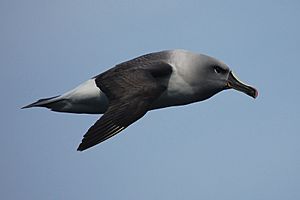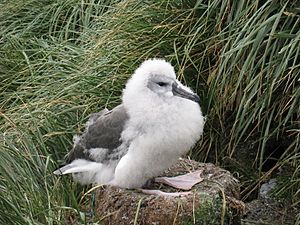Grey-headed albatross facts for kids
Quick facts for kids Grey-headed albatross |
|
|---|---|
 |
|
| Conservation status | |
| Scientific classification | |
| Genus: |
Thalassarche
|
| Species: |
chrysostoma
|
| Synonyms | |
|
Diomedea chrysostoma |
|
The grey-headed albatross (Thalassarche chrysostoma), also called the grey-headed mollymawk, is a large seabird. It belongs to the albatross family. This bird lives all around the Southern Ocean. It builds its nests on lonely islands there. It finds food in the far southern waters, further south than other mollymawks. Its name comes from its grey head, throat, and upper neck.
Contents
Understanding Albatrosses
Mollymawks are a type of albatross. They are part of the Diomedeidae family. This family is in the order Procellariiformes. Other birds in this group include shearwaters and storm petrels. These birds share special features.
First, they have unique nose passages called naricorns. These attach to the top part of their beak. Albatrosses have their nostrils on the sides of their beak. Also, the beaks of Procellariiformes birds are special. They are made of seven to nine hard plates.
Finally, these birds can make a special stomach oil. This oil is stored in their stomach. They use it to protect themselves from predators. It is also a rich food source for their chicks. Adult birds use it for energy during their long flights. They also have a salt gland above their nose. This gland helps remove salt from their bodies. It lets out a salty liquid from their nostrils. This helps them drink ocean water.
What Its Name Means
The name chrysostoma comes from two Greek words. Khrusos means "gold." Stoma means "the mouth." This name refers to the albatross's golden-colored beak.
How to Spot a Grey-Headed Albatross
The grey-headed albatross is about 81 cm (32 in) long. Its wings can spread up to 2.2 m (7.2 ft) wide. It usually weighs around 3.65 kg (8.0 lb).
This bird has a dark grey head, throat, and upper neck. Its upper wings, back, and tail are almost black. It has a white rump and underparts. There is also a white crescent shape behind its eyes. Its bill is black. It has bright yellow lines on the top and bottom edges. These lines turn pink-orange at the tip. The underside of its wings is white. It has a lot of black on the front edge and less on the back edge.
Young albatrosses look a bit different. They have a black beak and head. Their neck is darker. The white crescent near their eye is not very clear. Their underwing is almost completely dark.
Where Grey-Headed Albatrosses Live
| Location | Population | Date | Trend |
|---|---|---|---|
| South Georgia Island | 48,000 pairs | 2006 | Declining |
| Marion Island | 6,200 pairs | 2003 | Stable |
| Prince Edward Islands | 3,000 pairs | 2003 | |
| Campbell Island | 7,800 pair | 2004 | Declining |
| Macquarie Island | 84 pairs | 1998 | |
| Crozet Islands | 5,940 pairs | 1998 | |
| Kerguelen Islands | 7,905 pairs | 1998 | |
| Islas Diego Ramirez | 16,408 pairs | 2002 | |
| Total | 250,000 | 2004 | Decreasing |
Grey-headed albatrosses build their nests in large groups called colonies. They live on several islands in the Southern Ocean. Big colonies are found on South Georgia in the South Atlantic. Smaller groups live on Islas Diego Ramírez, Kerguelen Islands, Crozet Islands, Marion Island, and Prince Edward Islands in the Indian Ocean. They also nest on Campbell Island and Macquarie Island south of New Zealand, and in Chile.
When they are breeding, they search for food near or south of the Antarctic Polar Frontal Zone. This is a cold water area. Birds from the Marion Island area look for food in warmer, sub-tropical waters. Young birds or adults not breeding fly freely across all the southern oceans. They can go as far north as 35°S.
Albatross Behaviour
How They Find Food
At sea, the grey-headed albatross spends most of its time in the open ocean. It is more pelagic than other mollymawks. This means it prefers to feed far from land, not over the continental shelves. They mostly eat squid. They also eat some fish, crustacea, dead animals, and lampreys. Krill is not a main food source for them. This shows they prefer to hunt in the open ocean. They can dive as deep as 7 m (23 ft) to catch food. However, they do not dive very often.
Reproduction and Life Cycle
Female albatrosses lay one egg in a large nest. These nests are usually built on steep slopes or cliffs. They are often found among tussock grass. The egg is kept warm for 72 days until it hatches.
Studies on Bird Island show how chicks grow. A chick is fed about 616 g (21.7 oz) of food every 1.2 days. The chick grows to weigh around 4,900 g (170 oz). Chicks then tend to lose some weight before they learn to fly. This "fledging" happens after 141 days.
After learning to fly, chicks usually do not return to the colony for 6–7 years. They will not breed for the first time until several years after that. If a pair successfully raises a chick, they will not breed the next year. They take a year off. During this time away from the colony, they can travel huge distances. They often fly around the world many times.
Protecting the Grey-Headed Albatross

The IUCN lists this bird as endangered. This is because its numbers are quickly dropping. About half of the world's population lives in South Georgia.
The grey-headed albatross lives across a huge area of 79,000,000 km2 (31,000,000 sq mi). Its breeding areas cover 1,800 km2 (690 sq mi). In 2004, the total population was estimated to be 250,000 birds. This included 48,000 pairs at South Georgia Island. There were also 6,200 pairs on Marion Island, 3,000 pairs on Prince Edward Islands, and 7,800 pairs on Campbell Island. Other populations include 16,408 pairs in Chile, 84 pairs on Macquarie Island, 5,940 on Crozet Island, and 7,905 on Kerguelen Islands.
The number of these birds has been shrinking. On Bird Island, numbers have dropped by 20% to 30% in the last 30 years. On Marion Island, numbers went down by 1.75% each year until 1992. Now, the population seems stable there. Campbell Island has seen a big drop of 79% to 87% since the 1940s. Overall, the population has likely gone down by 30-40% over 90 years.
One major threat is fishing. In the Indian Ocean, some fishing for the Patagonian toothfish caused many albatross deaths. In 1997 and 1998, between 10,000 and 20,000 albatrosses died, mostly this species. Longline fishing is also responsible for many deaths.
To help this species, studies are being done on most of the islands where they live. Also, Prince Edward Islands is a special nature preserve. Campbell Island and Macquarie Island are both World Heritage Sites.
See also
 In Spanish: Albatros de cabeza gris para niños
In Spanish: Albatros de cabeza gris para niños



